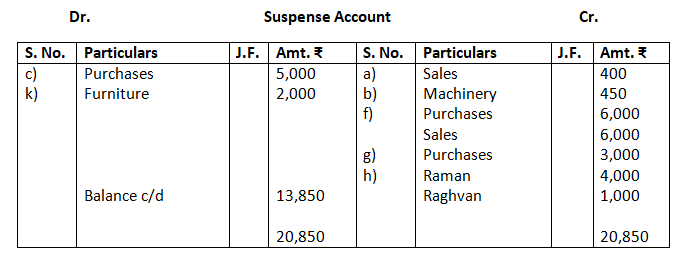Short Answer
- State the meaning of a trial balance?
Solution:- Trial balance is a statement prepared to check the arithmetical accuracy of transactions recorded in the journal, posted into the ledger and balanced in the ledger accounts. The balance of ledger account shows the difference between the total of the debit items and credit items in an account. Personal, real and nominal accounts are considered for preparing the trial balance. Generally, it is prepared at the end of an accounting year. However, it may be prepared at the end of any chosen period, which may be monthly, quarterly, half yearly or annually depending upon when it is required. It helps in the preparation of the financial statements.
2. Give two examples of errors of principle?
Solution:- ‘Errors of principle’ refer to those errors that are committed when recording of transactions is done against the accounting principle. Below given are the examples of error of principle.
- Wages paid for construction of building debited to Wages Account – In this transactions, wages paid for the construction of building is a capital expenditure and accordingly building account should have been debited. However, in this case, it is treated as revenue expenditure and is debited to Wages Account. This error violates the accounting principle.
- Amount spent on repair of machinery debited to Machinery Account – In this transaction, amount of repair is a revenue expenditure and not a capital expenditure. It should have been debited as ‘Repairs’, but was wrongly debited to the Machinery Account.
3. Give two examples of errors of commission?
Solution:- The two examples of error of commission are as follows:
- Posting of wrong amount – Goods for Rs.9,000 have been purchased from mohit. However, while posting to Mohit’s credit in the purchase book, if the amount posted is Rs.900 in place of Rs.9000, the trial balance will be different.
- Posting on the wrong side – Goods for Rs.5000 have been purchased from Ram. Instead of posting it to the credit side, the entry was recorded on the debit side of Tam’ a/c, making the trial balance increase the credit by Rs.5000.
4. What are the methods of preparing trail balance?
Solution:- A trial balance can be prepared in the following three ways:
- Total Method – In this method, the total of the debit and the credit side of the ledger is determined and presented separately in the trial balance. The total of both the sides should match as the accounts are based on double-entry system.
- Balance Method – In this method, the balance of all ledger accounts are presented in their respective debit and credit columns of the trial balance. The total of both the sides should match as the accounts are based on double-entry system and this method of preparing a trial balance is widely used because it helps in the preparation of financial statements.
- Totals-cum-balances Method – this method is a blend of the totals and balances method. This method has four columns. The first two columns are to write the totals of the debits and credits of the balances of these accounts. This method is time-consuming, and hence are not used widely.
5. What are the steps taken by an accountant to locate the errors in the trial balance?
Solution:- The following are various steps that an accountant takes to locate the errors in the trial balance:
- Re-totalling of the debit and the credit columns of the Trial Balance to locate the difference in the total of both the columns.
- Checking whether any account is omitted to be recorded with the exact difference amount.
- Half the difference, then check whether any amount is posted in the wrong column of the Trial Balance.
- Divide the difference by 9, if it is completely divisible, it is and error of transposition of figure, i.e. 546 is written as 645.
- If there exist differences especially of Rs.1, Rs.10, Rs.100, Rs.1000, etc., it suggests that the casting of Subsidiary Books should be checked once again.
- If difference still exists and it is not possible to detect the reason for the difference, then for the time being, the difference is transferred in the suspense account in order to proceed further. Otherwise, a complete checking is suggested.
6. What is a suspense account? Is it necessary that is suspense account will balance off after rectification of the errors detected by the accountant? If not, then what happens to the balance still remaining in suspense account?
Solution:- The suspense account is referred to as the account which is prepared during the times of the errors in the trial balance when the balances of the debit and the credit side so bot match with each other. This account hence records the difference of both the sides of the trial balance to record the differing amount under its head. This discrepancy in the amount of the debit and the credit column occurs due to the error in the accounting process.
7. What kinds of errors would cause difference in the trial balance. Also list examples that would not be revealed by a trial balance?
Solution:- One-sided errors are the errors which when committed affect the agreement of the trial balance. These errors affect only one account and anyone side i.e. debit or the credit side of the account. Errors of partial omission, recording transactions with wrong amount, casting, posting of incorrect amount are examples of one-sided errors. Two-sided errors do not affect the agreement of the trial balance.
Here, are few examples which would not be revealed in a trial balance:
- Purchases from Mr.Shah, completely omitted to be recorded in the purchase book.
- Purchases made from Vijesh, recorded in Ritesh’s account who is another creditor.
- Stationary purchased for office use recorded in the purchase book.
8. State the limitations of trail balance?
Solution:- If the Trial Balance agrees, then it should not be taken for granted, that there is absolutely no errors. In fact, there do exist some errors that are not revealed by a Trial Balance. Such ineffectiveness of the Trial Balance is termed as the limitations of Trial Balance.
The various limitations of the Trial Balance are given below:
- It does not assist to detect errors that arise if an entry is not recorded in the journal.
Such errors are termed as the Errors of Complete Omission.
- If the effect of one error is cancelled by the effect of another errors, then it cannot be ascertained by the Trial Balance.
Such types of errors are termed as Compensatory Errors, which are rare of find.
- If correct amount is posted in the correct side; however, in the wrong account and if wrong amount is posted in the wrong side, but in the correct account, then the Trial Balance fails to reflect these errors.
- If there arises any error of principle, like capital expenditure mistakenly regarded as revenue expenditure or vice-versa, then such errors may not be revealed in form of mismatch between the two columns of the Trial Balance.
- If any transaction is recorded wrongly in the books of original entry, then such mistakes lead to the errors of recording which are not revealed by Trial Balance.
Long Answers
- Describe the purpose for the preparation of trial balance.
Solution:- The important purposes for which the trial balance was prepared are explained with the help of the following points:
- Ascertain the arithmetical accuracy of ledger accounts – the trial balance helps to ascertain whether all the debits and credit are properly recorded in the ledger. When the debit and the credit balances are equal, it is said that the posting and the balancing of the accounts is arithmetically correct. However the tallying of the trial balance cannot be considered as a conclusive proof of accuracy of the books.
2. Helps in locating errors – When a trial balance does not tally, it helps in detecting or locating the errors.
The error may occurred at any one of the stages of an accounting process; namely,
- Totaling of the subsidiary books
- Posting of journal entries in the ledger
- Calculating account balances
- Carrying account balances to the trial balance
- Totaling the trial balance columns
3. Helps in the preparation of the financial statements – Trial balance is a statement which lists the debit and credit balances of all ledger accounts and helps in the preparation of the financial statements. Hence, it is considered as a connecting link between the accounting records and the preparation of financial statements.
2. Explain errors of principle and give two examples with measures to rectify them.
Solution:- Errors of Principle refer to those errors that are committed when recording of transactions in the original book of entry is done against the accounting principle. These errors and not reflected in the Trial Balance. These errors are committed when proper distinction is not made between capital expenditure and revenue expenditure, or vice versa or between capital income and revenue income or vice versa. The following example will illustrate the process of understanding and rectification of such errors. Let us consider first example. Wages paid for construction of building are debited to wages Account.
Wrong entry made is:
Wages A/c Dr.
To Cash A/c
(Wages paid in cash)
In this case, wages paid for the construction of building should be treated as a capital expenditure and accordingly should be debited to the building account. However the Wages Account is wrongly debited.
Thus, the correct entry that should have been made is:
Building A/c Dr.
To Cash A/c
(Wages paid for construction of building)
In order to rectify this error, the rectifying entry should be:
Building A/c Dr.
To wages A/c
(Wages paid for construction of building was debited to Wages Account, now rectified)
The second example of errors of principle is the sale of old machinery recorded as sales.
Wrong entry made:
Cash A/c Dr.
To Sales A/c
(Sales of old machinery recorded as sales)
In this case, the sale of old machinery should not be recorded as sales; in fast the Machinery Account should be credited.
Thus, the correct entry that should have been made is:
Cash A/c Dr.
To Machinery A/c
(Old machinery, recorded as sales)
In order to rectify this error, Sales Account will be debited, as it is wrongly credited and machinery will be credited, as it will not be recorded in the books.
Thus, the rectifying entry will be:
Sales A/c Dr.
To Machinery A/c
(Sale of old machinery recorded as sales, now rectified)
3. Explain the errors of commission and give two examples with measures to rectify them.
Solution:- Errors of commission are the mistakes which occur due to the negligence of bookkeeper, clerks by recording a transaction with wrong amounts, wrong balancing, wrong posting and/or wrong carrying forwarded of an item of an account.
The following example will ensure the process of understanding and rectification of following errors:
- Let us consider the first example.
Sales made to Mr. X of s. 10,000 recorded a 1,000 from invoice. In this case, Mr. X’s account has been debited with Rs.1,000 instead of Rs.10,000; So the error of commission, it should be further debited with Rs.9,000.
This will be rectified by passing the following entry:

b. Purchase book was undercast by Rs.10,000.
This error can be rectified in any of the following two ways:
- If an error is located before preparing trial balance, then Rs.10,000 should be recorded in the debit side of Purchases Account.
- If an error is located after preparing Trial Balance, then the following entry needed to be recorded.

4. What are the different types of errors that are usually committed in recording business transaction.
Solution:- According to the nature of errors committed, errors are classified into the following four categories:
- Errors of Commission – The errors that are committed because of wrong posting of transactions, wrong balancing of accounts, wrong casting of subsidiary books, wrong totaling or wrong recording of amount in the books are all error of commission. These errors affect the agreement of the trial balance.
- Errors of Omission – These errors are of two types and are committed when a transaction is partially or completely omitted to be recorded in the books.
- Error of complete omission – When a transaction is completely omitted to be recorded in the books of accounts or to be posted in the respective ledgers, it is an error of complete omission. Such errors do not affect the agreement of the trial balance.
- Error of partial omission – When a transaction is partially omitted while recording in the books or amounts or partially omitted from posting in the ledger, it is an error of partial omission. Such errors affect the agreement other trial balance.
- Errors of Principle – Accounting transactions are to be recorded following certain principles. If any of the principle of accounting entries are violated or ignored and the error occurring due to such violation is called error of principle.
- Compensating errors – When two or more errors are committed in such a way that the net effect on the debits and credits of accounts in nil, such errors are called compensating errors.
5. As on accountant of a company, you are disappointed to learn that the totals in your new trial balance are not equal. After going through a careful analysis, you have discovered only one error. Specifically, the balance of the Office Equipment account has a debit balance of Rs.15,600 on the trial balance. However, you have figured out that a correctly recorded credit purchase of pen drive for Rs.3,500 was posted from the journal to the ledger with a Rs.3,500 debit to creditors accounts. Answer each of the following questions and present the amount of any misstatement:
- Is the balance of the office equipment account overstated, understated, or correctly stated in the trial balance?
- Is the balance of the creditors account overstated, understated, or correctly stated in the trial balance?
- Is the debit column total of the trial balance overstated, understated, or correctly stated?
- Is the credit column total of the trial balance overstated, understated, or correctly stated?
- If the debit column total of the trial balance is Rs.2,40,000 before correcting the error, what is the total of credit column.
Solution:- Pen-drive is wrongly debited to office equipment account, instead of stationery account and supplier account is debited instead of crediting.
Because of these mistakes, the following errors are committed:
- The balance of office equipment is overstated by Rs.3,500
- The balance of creditors account is understated by Rs.7,000
- The total of the debit column of the trial balance is correctly stated.
- The total of the credit column of the trial balance is understated by Rs.7,000.
- If the total of the debit column of the trial balance is Rs.2,40,000 before rectifying error, the total of the credit column of the trial balance is Rs.2,33,000 (i.e., rs.2,40,000 – Rs.7,000).
Numerical Questions
- Rectify the following errors:
- Credit sales to Mohan Rs.7,000 were not recorded.
- Credit purchases from Rohan Rs.9,000 were not recorded.
- Goods returned to Rakesh Rs.4,000 were not recorded.
- Goods returned from Mahesh Rs.1,000 were not recorded.
Solution:-
Journal
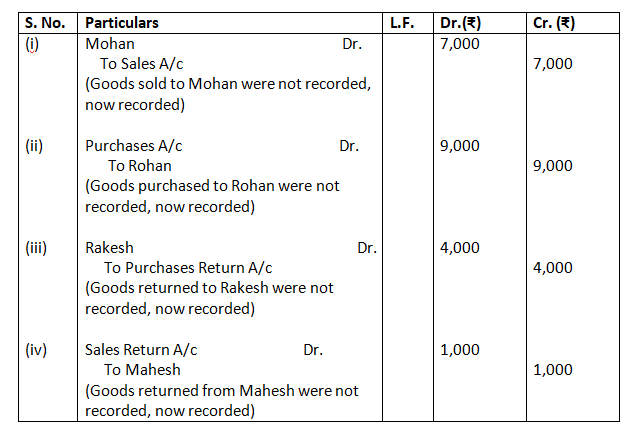
2. Rectify the following errors:
- Credit sales to Mohan Rs.7,000 were recorded as Rs.700.
- Credit purchases from Rohan Rs.9,000 were recorded as Rs.900.
- Goods returned to Rakesh Rs.4,000 were recorded as Rs.400.
- Goods returned from Mahesh Rs.1,000 were recorded as Rs.100.
Solution: –
Journal
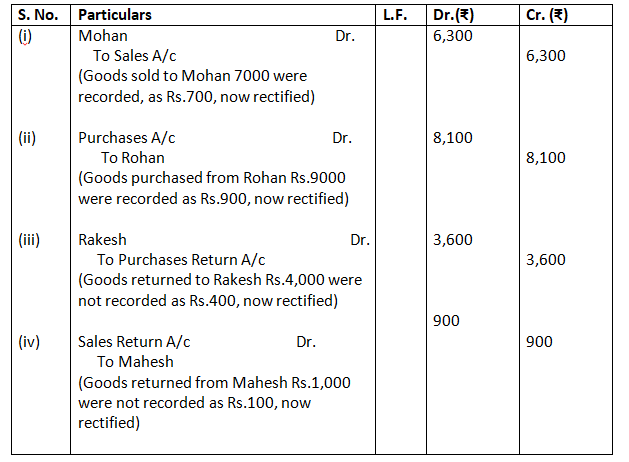
3. Rectify the following errors:
- Credit sales to Mohan Rs.7,000 were recorded as Rs.7,200.
- Credit purchases from Rohan Rs.9,000 were recorded as Rs.9,900.
- Goods returned to Rakesh Rs.4,000 were recorded as Rs.4,040.
- Goods returned from Mahesh Rs.1,000 were recorded as Rs.1,600.
Solution:-
Journal
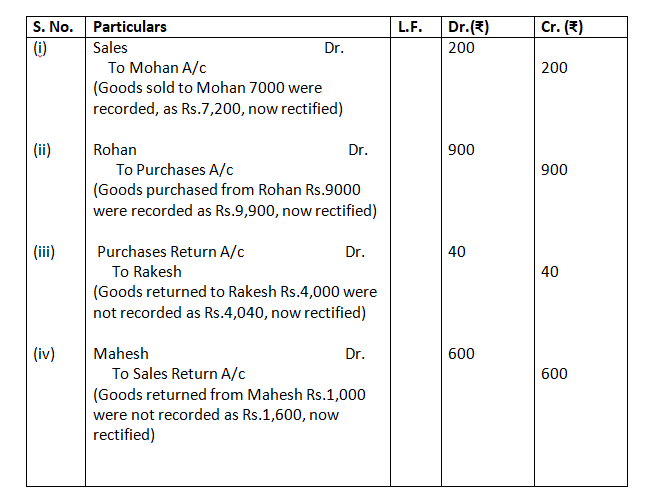
4. Rectify the following errors:
- Salary paid Rs.5,000 was debited to employee’s personal account.
- Rent Paid Rs.4,000 was posted to landlord’s personal account.
- Goods withdrawn by proprietor for personal use Rs.1,000 were debited to sundry expenses account.
- Cash received from Kohli Rs.2,000 was posted to Kapur’s account.
- Cash paid to Babu Rs.1,500 was posted to Sabu’s account.
Solution:-
Journal
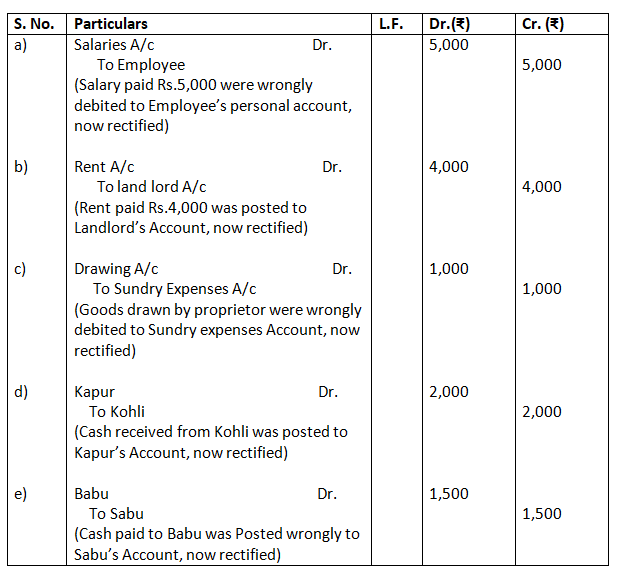
5. Rectify the following errors:
- Credit Sales to Mohan Rs.7,000 were recorded in purchases book.
- Credit Purchases from Rohan Rs.9,00 were recorded in sales book.
- Goods returned to Rakesh Rs.4,000 were recorded in the sales return book.
- Goods returned from Mahesh Rs.1,000 were recorded in purchases return book.
- Goods returned from Mahesh Rs.2,000 were recorded in purchases book.
Solution:-
Journal
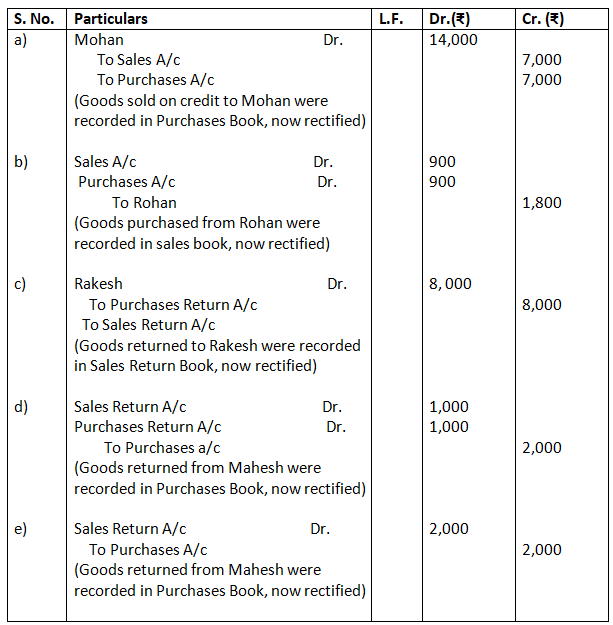
6. Rectify the following errors:
- Sales book overcast by Rs.700
- Purchases book overcast by Rs.500.
- Sales return book overcast by Rs.300
- Purchase return book overcast by Rs.200.
Solution:-
Journal
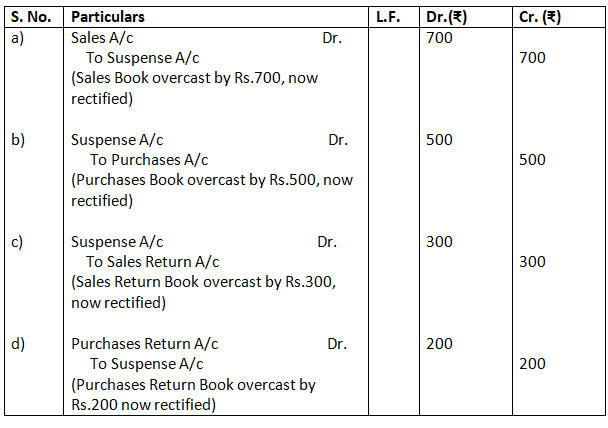
7. Rectify the following errors:
- Sales book undercast by Rs.300.
- Purchases book undercast by Rs.400.
- Return Inwards book undercast by Rs.200.
- Return outwards book undercast by Rs.100.
Solution:-
Journal
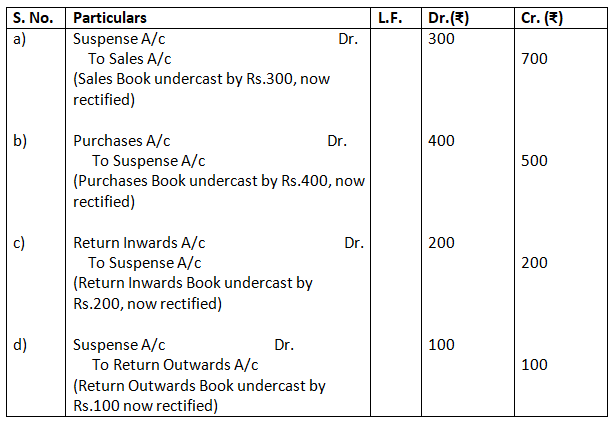
8. Rectify the following errors and ascertain the amount of different in trial balance by preparing suspense account:
- Credit sales to Mohan Rs.7,000 were not posted.
- Credit purchases from Rohan Rs.9,000 were not posted.
- Goods returned to Rakesh Rs.4,000 were not posted.
- Goods returned from Mahesh Rs.1,000 were not posted.
- Cash paid to Ganesh Rs.3,000 was not posted.
- Cash sales Rs.2,000 were not posted.
Solution:-
Journal
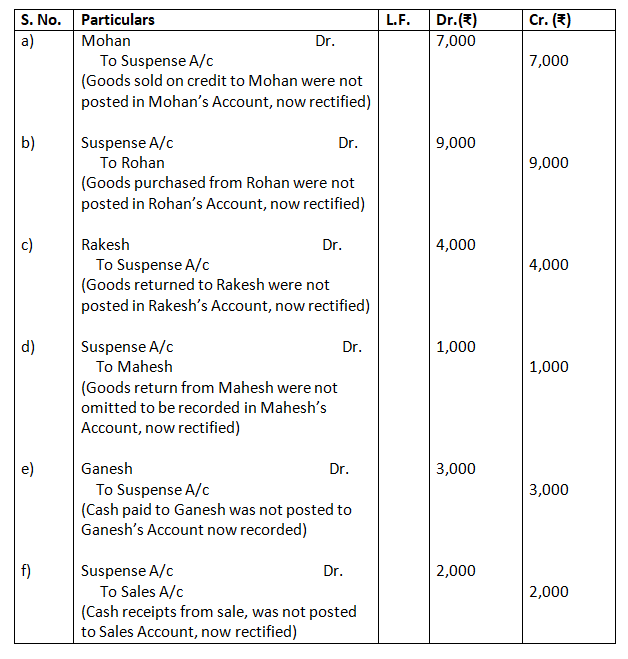

Note:- in order to match the balance of suspense account, it has been assumed that all errors given in the question are errors of partial omission.
9. Rectify the following errors and ascertain the amount of different in trial balance by preparing suspense account:
- Credit sales to Mohan Rs.7,000 were posted as Rs.9,000.
- Credit purchases from Rohan Rs.9,000 were posted as Rs.5,000.
- Goods returned to Rakesh Rs.4,000 were posted as Rs.5,000.
- Goods returned from Mahesh Rs.1,000 were posted as Rs.3,000.
- Cash sales Rs.2,000 were posted as Rs.200.
Solution:-
Journal
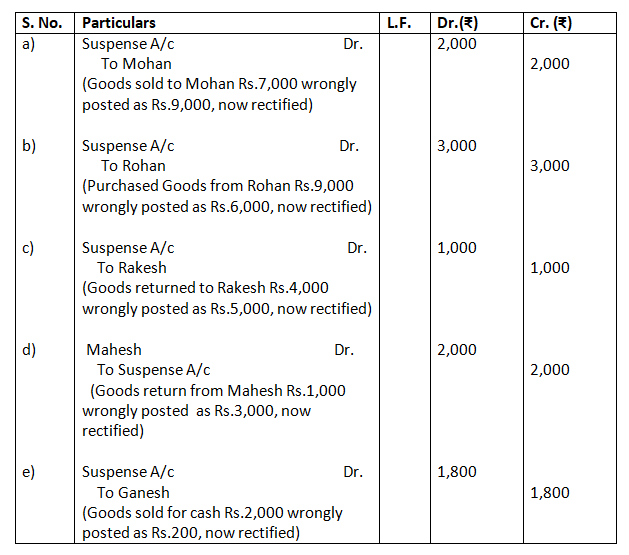

Note:- In order to match answer with that of the answer given in the book it has been it has been assumed that all the errors mentioned in this question are errors of partial omission.
10. Rectify the following errors:
- Credit sales to Mohan Rs.7,000 were posted to Karan.
- Credit purchases from Rohan Rs.9,000 were posted to Gobind.
- Goods returned to Rakesh Rs.4,000 were posted to Naresh.
- Goods returned from Mahesh Rs.1,000 were posted to Manish.
- Cash sales Rs.2,000 were posted to commission account.
Solution:-
Journal
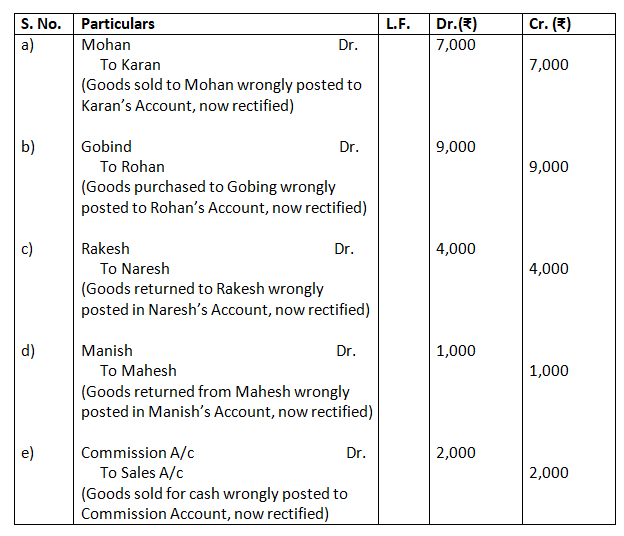
11. Rectify the following errors assuming that a suspense account was opened. Ascertain the difference in trial balance.
- Credit sales to Mohan Rs.7,000 were posted to the credit of his account.
- Credit purchases from Rohan Rs.9,000 were posted to the debit of his account as Rs.6,000.
- Goods returned to Rakesh Rs.4,000 were posted to the credit of his account.
- Goods returned from Mahesh Rs.1,000 were posted to the debit of his account as Rs.2,000.
- Cash sales Rs.2,000 were posted to the debit of sales account as Rs.5,000.
Solution:-
Journal
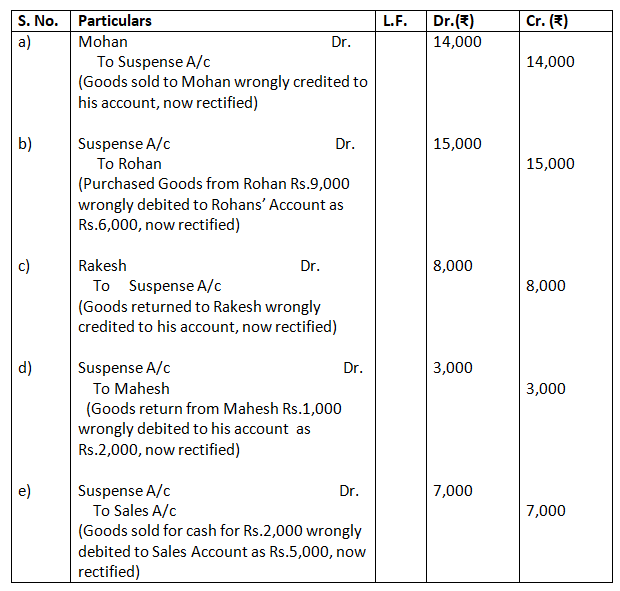

12. Rectify the following errors assuming that a suspense account was opened. Ascertain the different in trial balance.
- Credit sales to Mohan Rs.7,000 were posted to Karan as Rs.5,000.
- Credit purchases from Rohan Rs.9,000 were posted to the debit of Gobing as 10,000
- Goods returned to Rakesh Rs.4,000 were posted to the credit of Naresh as Rs.3,000.
- Goods returned to Rakesh Rs.1,000 were posted to the debit of Manish as Rs.2,000.
- Cash sales Rs.2,000 were posted to commission account as Rs.200.
Solution:-
Journal
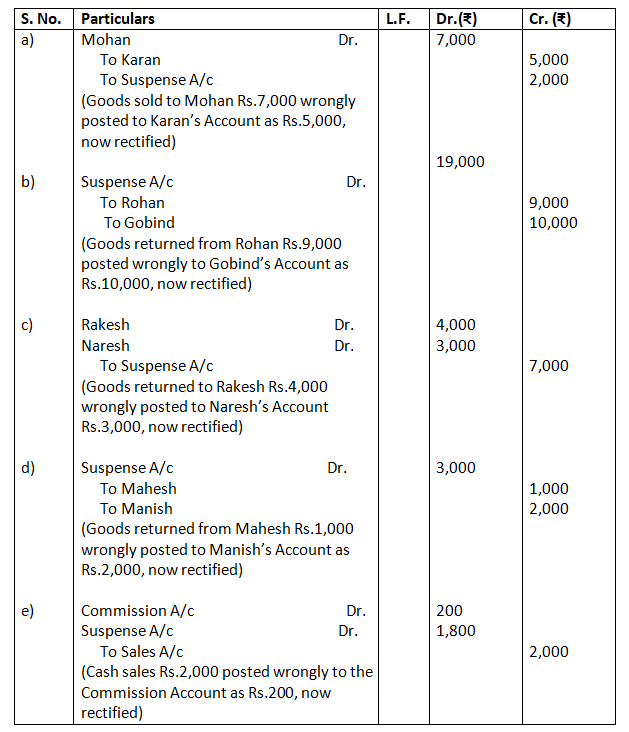

13. Rectify the following errors assuming that suspense account was opened. Ascertain the difference in trial balance.
- Credit sales to Mohan Rs.7,000 were recorded in Purchases Book. However, Mohan’s account was correctly debited.
- Credit purchases from Rohan Rs.9,000 were recorded in sales book. However, Rohan’s account was correctly debited.
- Goods returned to Rakesh Rs.4,000 were recorded in sales return book. However, Rakesh’s account was correctly debited.
- Goods returned from Mahesh Rs.1,000 were recorded through purchases return book. However, Mahesh’s account was correctly credited.
- Goods returned to Naresh Rs.2,000 were recorded through purchases book. However, Naresh’s account was correctly debited.
Solution:-
Journal

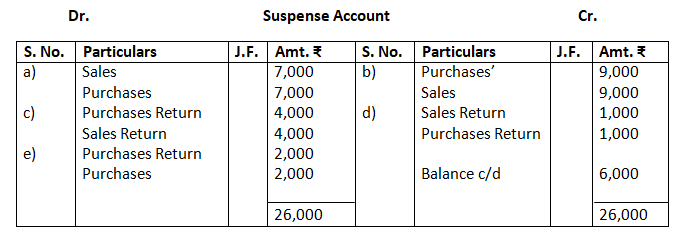
14. Rectify the following errors:
- Furniture purchased for Rs.10,000 wrongly debited to purchases account.
- Machinery purchased on credit from Roman for Rs.20,000 was recorded through purchases book.
- Repairs on machinery Rs.1,400 debited to machinery account.
- Repairs on overhauling of secondhand machinery purchased Rs.2,000 was debited to Repairs account.
- Sale of old machinery at book value of Rs.3,000 was credited to sales account.
Solution:-
Journal

15. Rectify the following errors assuming that suspension account was opened. Ascertain the difference in trial balance.
- Furniture purchased for Rs.10,000 wrongly debited to purchase account as Rs.4,000.
- Machinery purchased on credit from Raman for Rs.20,000 recorded through Purchases Book as Rs.6,000.
- Repairs on machinery Rs.1,400 debited to Machinery account as Rs.2,400.
- Repairs on overhauling of second hand machinery purchases Rs.2,000 was debited to Repairs account as Rs.200.
- Sale of old machinery at book value Rs.3,000 was credited to sales account as Rs.5,000.
Solution:-
Journal
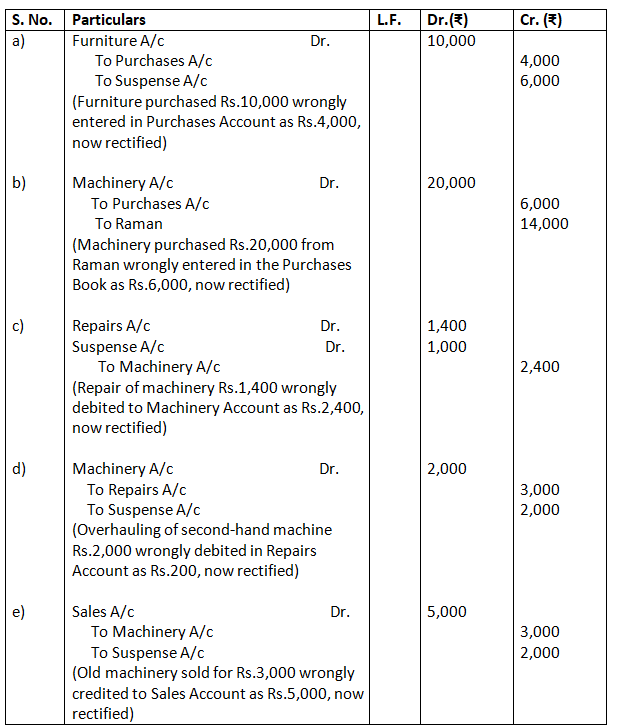

16. Rectify the following errors:
- Depreciation provided on machinery Rs.4,000 was not posted.
- Bad debts written off Rs.5,000 were not posted.
- Discount allowed to a debtor Rs.100 on receiving cash from him was not posted.
- Discount allowed to a debtor Rs.100 on receiving cash from him was not posted to discount account.
- Bill receivable for Rs.2,000 received from a debtor was not posted.
Solution:-
Journal
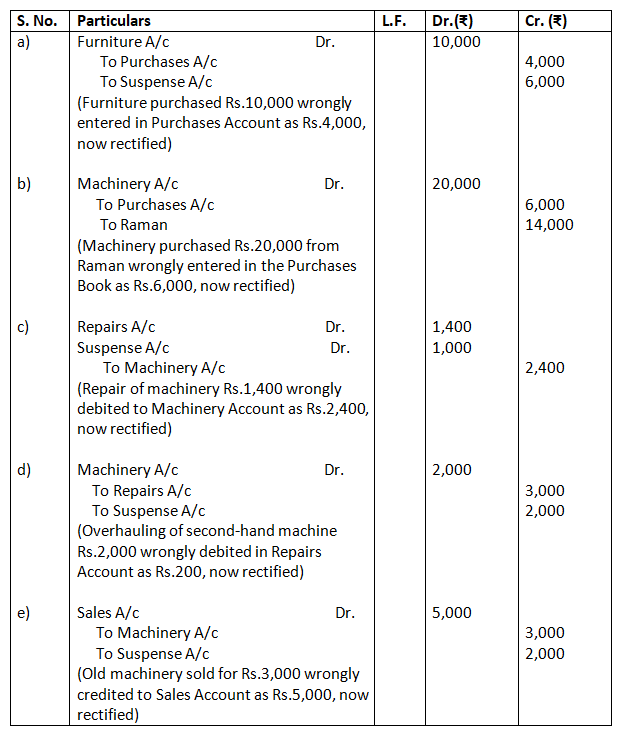
17. Rectify the following errors:
- Depreciation provided on machinery Rs.4,000 was posted as Rs.400.
- Bad debts written off Rs.5,000 were posted as Rs.6,000.
- Discount allowed to a debtor Rs.100 on receiving cash from him was posted as Rs.60.
- Goods withdrawn by proprietor for personal use Rs.800 were posted as Rs.300.
- Bill receivable for Rs.2,000 received from a debtor was posted as Rs.3,000.
Solution:-
Journal
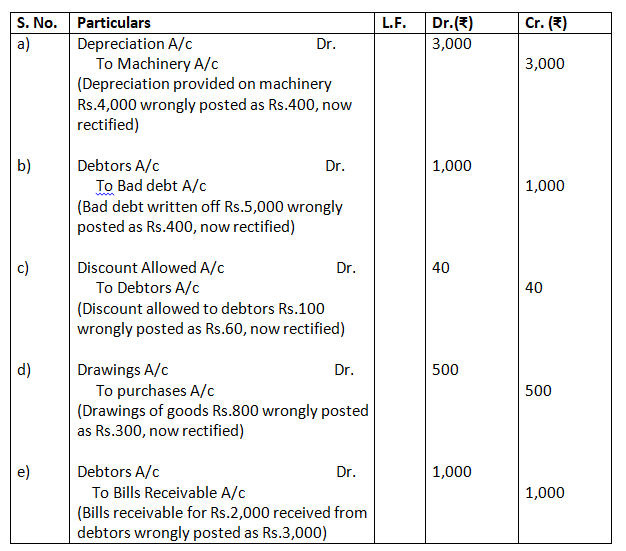
18. Rectify the following errors assuming that suspense account was opened. Ascertain the difference in trial balance.
- Depreciation provided on machinery Rs.4,000 was not posted to Depreciation account.
- Bad debts written-off Rs.5,000 were not posted to Debtors account.
- Discount allowed to a debtor Rs.100 on receiving cash from him was not posted to discount allowed account.
- Goods withdrawn by proprietor for personal use Rs.800 were not posted to Drawing account.
- Bill receiving for Rs.2,000 received from a debtor was not posted to Bills receivable account.
Solution:-
Journal
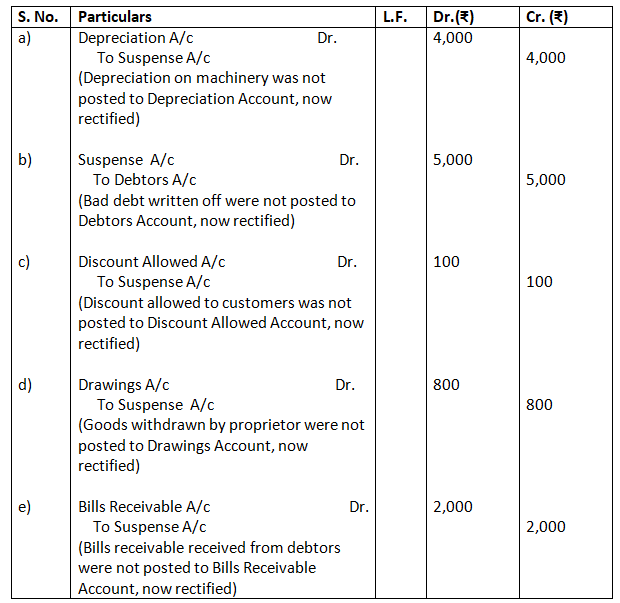

19. Trial balance of Anuj did not agree. It showed an excess credit of Rs.6,000. He put the difference to suspense account. He discovered the following errors
- Cash received from Ravish Rs.8,000 posted to his account as Rs.6,000.
- Returns inwards book overcast by Rs.1,000.
- Total of sales book rs.10,000 was not posted to Sales account.
- Credit purchases from Nanak Rs.7,000 were recorded in sales Book. However, Nanak’s account was correctly credited.
- Machinery purchased for rs.10,000 was posted to purchases account as Rs.5,000. Rectify the errors and prepare suspense account.
Solution:-
Journal
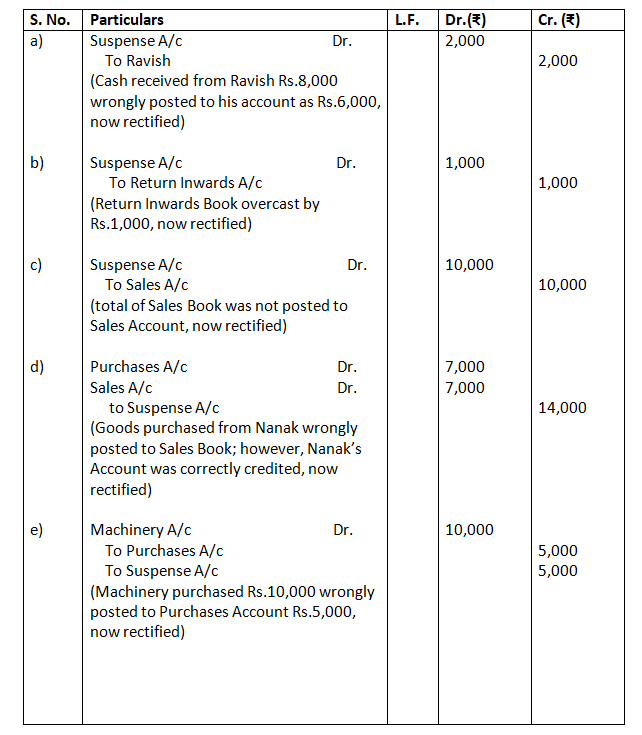

20. Trial balance of Raju showed an excess debit of Rs.10,000. He put the difference to suspense account and discovered the following errors:
- Depreciation written-off the furniture Rs.6,000 was not posted to Furniture account.
- Credit sales to Rupam Rs.10,000 were recorded as Rs.7,000.
- Purchases book undercast by Rs.2,000.
- Cash sales to Rana Rs.5,000 were not posted.
- Old Machinery sold for Rs.7,000 was credited to sales account.
- Discount received Rs.800 from kanan on playing cash to him was not posted. Rectify the errors and prepare suspense account.
Solution:-
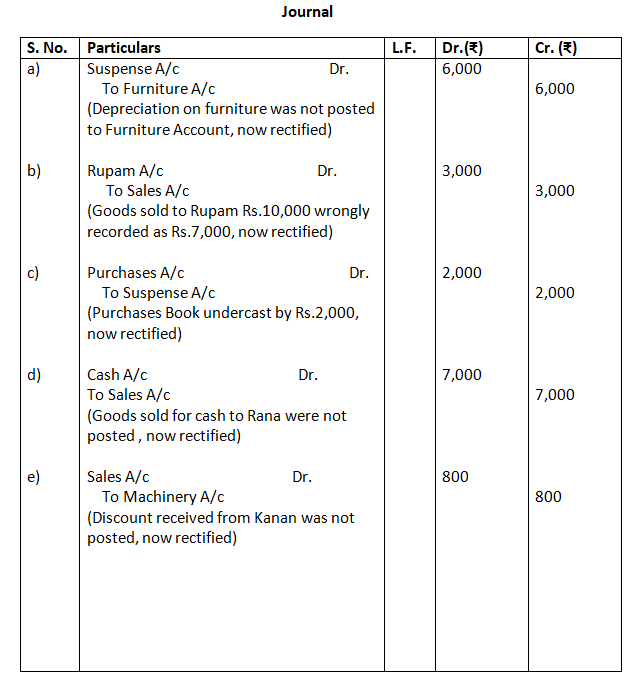

Note: As per the solution, suspense account shows the credit balance of Rs.6,000. However, in the book the answer is credit balance of Rs.1,000. So, in order to match the answer with the book item (d) is taken as, ‘Cash Sales to Rana Rs.5,000 were not posted to the sales account.’
Thus, the rectifying entry of this error will be:
Suspense A/c Dr. 5,000
To Sales A/c 5,000
21. Trial balance of Madan did not agree and he put the difference to suspense account. He discovered the following errors:
- Sales return book overcast by Rs.800.
- Purchases return to Sahu Rs.2,000 were not posted.
- Goods purchased on credit from Narula Rs.4,000 through taken into stock, but no entry was passed in the books.
- Installation charges on new machinery purchases Rs.500 were debited to sundry expenses account as Rs.50.
- Rent paid for residential accommodation of madam (the proprietor) Rs.1,400 was debited to Rent account as Rs.1,000.
Rectify the errors and prepare suspense account to ascertain the different in trial balance.
Solution:-
Journal
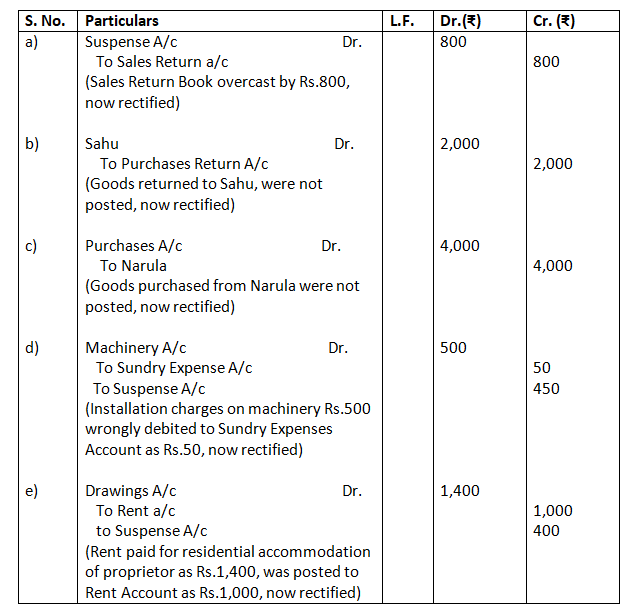

Note: As per the solution, suspense account shows the credit balance of Rs.50. However, in the book the answer is credit balance of Rs.2050. In order to match the answer with the book item (b) is taken as, ‘Purchases return to Sahu Rs.2,000 were not posted to Sahu’s Account.’
Thus, the rectifying entry of this error will be:
Sahu’s A/c Dr. 2,000
To Suspense A/c 2,000
22. Trial balance of Kohil did not agree and showed an excess of Rs.16,300. He put the difference to a suspense account and discovered the following errors:
- Cash received from Rajat Rs.5,000 was posted to the debit of Kamal as Rs.6,000.
- Salaries paid to an employed Rs.2,000 were debited to his personal account as Rs.1200.
- Goods withdrawn by proprietor for personal use Rs.1,000 were credited to sales account as Rs.1,600.
- Depreciation provided on machinery Rs.3,000 was posted to Machinery account as Rs.300.
- Sale of old car for Rs.10,000 was credited to sales account as Rs.6,000. Rectify the errors and prepare suspense account.
Solution:-
Journal
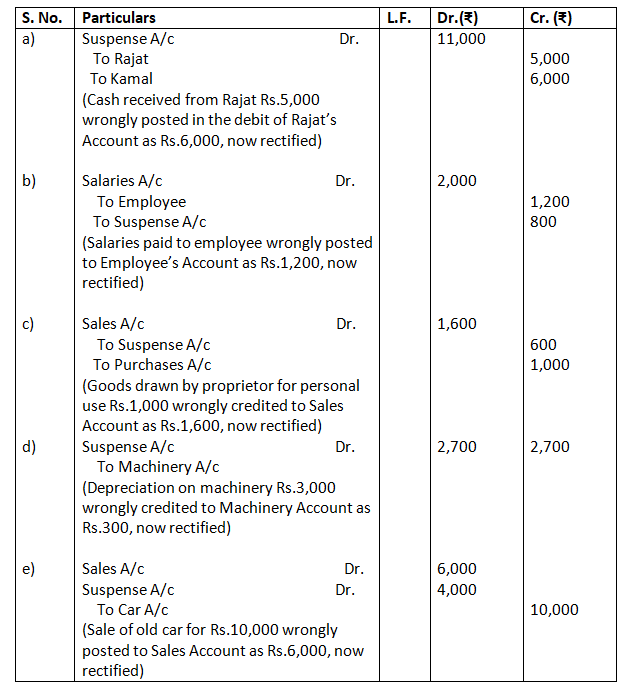

23. Give journal entries to rectify the following errors assuming that suspense account had been opened.
- Goods distributed as free sample Rs.5,000 were not recorded in the books.
- Goods withdrawn for personal use by the proprietor Rs.2,000 were not recorded in the books.
- Bill receivable received from a debtor Rs.6,000 was not posted to his account.
- Total of Returns inwards book Rs.1,200 was posted to Returns outwards account.
- Discount allowed to Reema Rs.700 on receiving cash from her was recorded in the books as Rs.70.
Solution:-
Journal
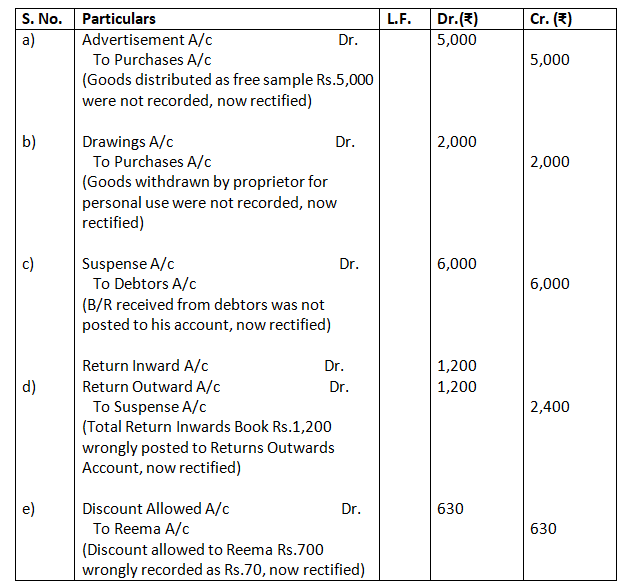

24. Trial balance of Khatau did not agree. He put the difference to suspense account and discovered the following errors:
- Credit sales to Manas Rs.16,000 were recorded in the purchases book as Rs.10,000 and posted to the debit of Manas as Rs.1,000.
- Furniture purchases from Noor Rs.6,000 was recorded through purchases book as Rs.5,000 and posted to the debit of Noor Rs.2,000.
- Goods returned to Rai Rs.3,000 recorded through the Sales book as Rs.1,000.
- Old machinery sold for Rs.2,000 to Maneesh recorded through sales book as Rs.1,800 and posted to the credit of Manish as Rs.1,200.
- Total of Returns inwards book Rs.2,800 posted to Purchase account.
Rectify the above errors and prepare suspense account to ascertain the difference in trial balance.
Solution:-
Journal


25. Trial balance of Johan did not agree. He put the difference to suspense account and discovered the following errors:
- In the sales book for the month of January total of page 2 was carried forward to page 3 as Rs.1,000 instead of Rs.1200 and total of page 6 was carried forward to page 7 as Rs.5,600 instead of Rs.5,000.
- Wages paid for installation of machinery Rs.500 was posted to wages account as Rs.50.
- Machinery purchased from R & Co. for Rs.10,000 on credit was entered in Purchase Book as Rs.6,000 and posted there from to R & co. as Rs.1,000.
- Credit sales to Mohan Rs.5,000 were recorded in Purchases Book.
- Goods returned to Ram Rs.1,000 were recorded in Sales Book.
- Credit purchases from S & Co. for Rs.6,000 were recorded in sales book. However, S & Co. was correctly credited.
- Credit purchases from M & Co. Rs.6,000 were recorded in Sales Book as Rs.2,000 and posted there from to the credit of M & Co. as Rs.1,000.
- Credit sales to Raman Rs.4,000 posted to the credit of Raghvan as Rs.1,000.
- Bill receivable for Rs.1,600 from Noor was dishonored and posted to debit of Allowances account.
- Cash paid to Mani Rs.5,000 against our acceptance was debited to Manu.
- Old furniture sold for Rs.3,000 was posted to Sales account as Rs.1,000.
- Depreciation provided on furniture Rs.800 was not posted.
- Material Rs.10,000 and wages Rs.3,000 were used for construction of building. No adjustment was made in the books.
Rectify the errors and prepare suspense to ascertain the difference in trial balance.
Solution:-
Journal
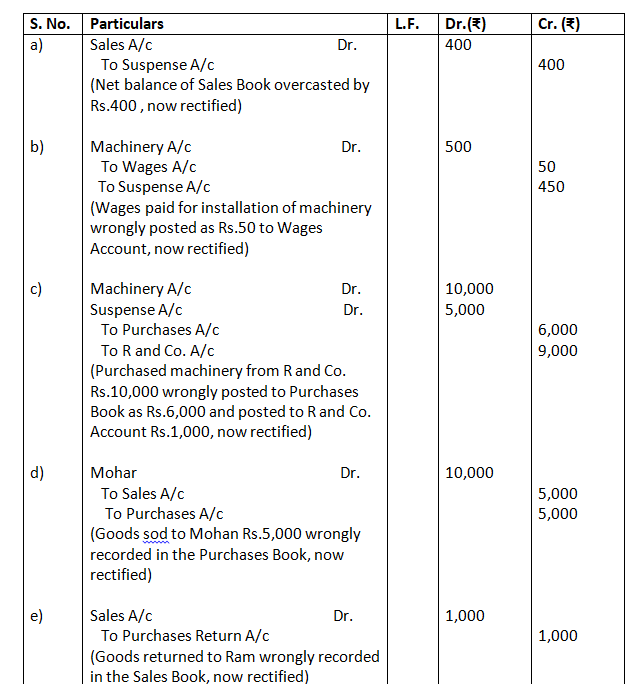
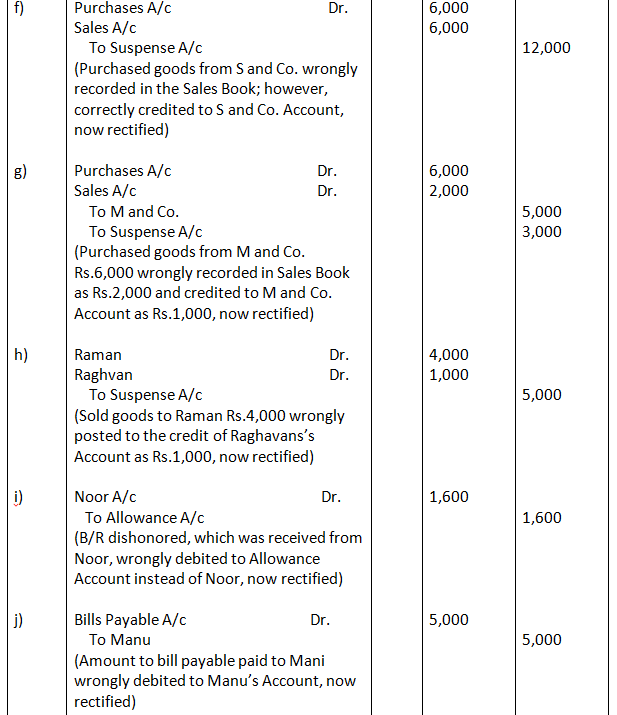
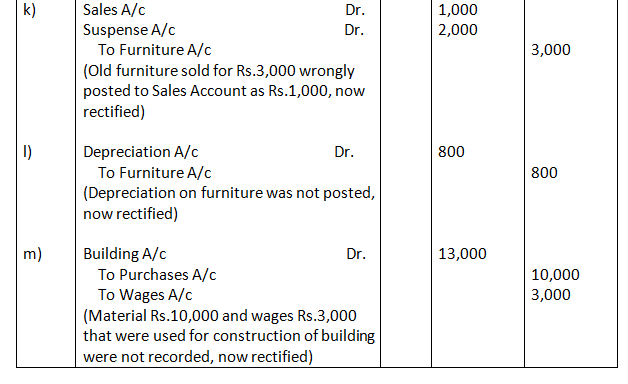
Note: In item (m), it has been assumed that the materials used in the construction of building are part of stock in trade.
